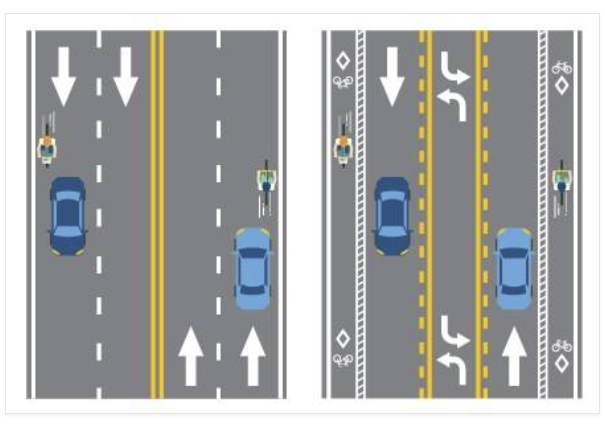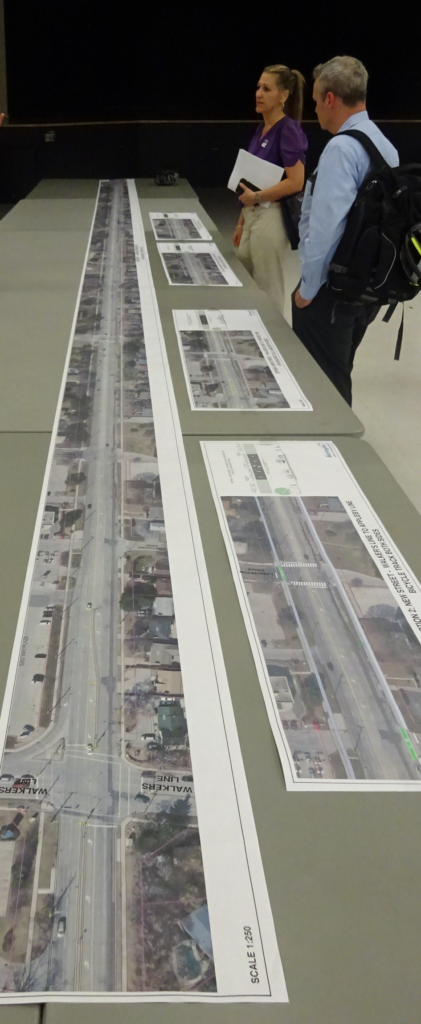 By Pepper Parr
By Pepper Parr
August 18, 2016
BURLINGTON, ON
A little less anxiety over the announcement that New Street traffic lanes are going to be re-configured from the two lanes each way to one lane each way, a centre turning lane and two buffered bike lanes on each side of the road would seem to be in order.
Road marking removal will take place starting August 22 to prepare the roads for lane-painting, which will begin on August 26. The road is expected to be ready on August 27.

Existing configuration on the left – planned configuration on the right.
Gazette commentators are getting themselves all wound up with some rather silly comments. Those rocket scientists have concluded the pilot project is going to be a traffic disaster.

Extensive maps showing the possible options for bike lanes on New Street were on display at a public meeting in May at Bateman High school.
No one really knows how this pilot project is going to work. It will run for a year and the evidence will tell the transportation department if what they tried worked or didn’t work.
All these comment, some of them downright silly, add little to the discussion – wait for the results.
You can bet that the transportation people will be monitoring this very closely and reporting regularly to the city manager. The city manager will certainly keep council advised; maybe he will find a way to share the data the city collects with the taxpayers.
No one knows if the pilot will work – can we not wait for the evidence before jumping to conclusions?
One hopes that the members of council don’t fold on this one and pull the plug before there is a decent chance to see if it works.
Here is a sampling of the comments that have come in – and it isn’t over.
“Utterly incredible and unbelievable! At a time when this City faces major problems with transportation gridlock a major east-west thoroughfare gets cut to one lane in each direction. Get behind a school or city bus and your commute will be extended significantly.”
“Shame on this Council for their lack of perspective, and shame on our Mayor for lacking the leadership and the guts to stand up to the bicycle lobby at City Hall who are intent on pursuing their agenda despite widespread community opposition. Kudos to Councillor Sharman for being the sole voice of reason, logic and common sense on this pathetic Council.”
“Wonderful- no more bikes in the car lanes! Now the bikes have more options finally- Burlington bike paths, Burlington sidewalks and the new bike lanes! Looking forward to improved snow removal and synchronized lights for bike safety. Next- running lanes? Shake your heads! Check out where the bike lanes are in Amsterdam”
“What on earth are they thinking????? The congestion at rush hour will be crazy. We already can’t move in Burlington, they keep building and building. Would like to see the study plan for this. Lakeshore does not work either by the way. Lived in Burlington my whole life, time to move.”
“It is finally now official, this is a City being run by incompetent Councillors and staff. They should all hang there head in shame.”
“Unbelievable! A main corridor being reduced. I understand Burlington’s obsessiveness but to take a full lane divide in 2, well it is an attraction for cyclists to run 5 or 6 abreast. Afterall, they run 2 and 3+ currently.”
Related article:In May




















ALL of this above to agree: Democratic voting system on important issues needs to be put in place. ONLINE voting system!!!!
@Stephen White. You will note that Chris Ariens did not respond to your idea to put it to a vote. Chris is quite content that his special interest lobby group–the Cycling Committee is able to influence City Hall decision making through lobbying. Despite representing less than 1% of all road users, the City funds/sponsors this lobby group which is able to lobby for changes to support its own HOBBY (the Cycling Committee always frames this as a transportation issue but in Burlington, it is not, nor will it ever be about transportation) to the detriment of the other 99% of road users. No, Stephen, this is not about democracy!
While Philip likes to rudely insinuate that the Cycling Committee is some type of elite athletic club, if he ever attended any of our meetings or met any of the members who volunteer their time and share their knowledge to make Burlington a safer place, maybe he would reconsider his continued PR campaign in the print media to stereotype and label the cycling community.
The recommendation for New St, road diet was presented by the city’s expert Transportation staff to Council at the D&I committee, and not only the Cycling Advisory Committee, but also the ITAC (Integrated Transportation Advisory Committee) and the Mayor’s Millenial Committee also presented in support of the proposal. Committee voted 5-2 to support the Staff report and Council approved 6-1 at Council. That’s how our democracy works.
Perhaps I misread or perhaps you mislead but I seem to remember a report BY THE CYCLING COMMITTEE, dated February 17, 2016, which was presented to the D & I Committee on options for NEW STREET–Option A was the “road diet” (actually, REDUCED LANES FOR MOTOR VEHICLE TRAFFIC). Am I missing something? Because this doesn’t appear to be what you are stating in your last post?
Editor’s note:
I think this argument has gone on long enough.
Nothing is being added to the debate.
You have all made your points.
The street diet is a one year pilot project; the Gazette will do as much as it can to get the data that is being collected and ensure the public is informed.
We don’t need bike lanes we already have miles of paved roads safe for cars, trucks, motorcyclists and yes even bicyclists.
What we really do need however is strict enforcement of the HTA and serious penalties for causing injury or death.
Some people like to fault our neighbours to the south but in these days of “Best Management Practices”, that our elected official spew endlessly we are way behind various states.
Get caught speeding in a road construction zone in NY twice and you lose your licence.
Cause injury or death in other states and it’s $5,000 – $15,000 AND Jail for up to 10 years. You don’t see too many American drivers behaving like idiots and oh yeah, they cut to speed down from 65 MPH (110Kmh) to 55 (90kmh) with 9′ lanes.
Traffic moves pretty smoothly even in a construction zone.
Construction on an overpass near Tilbury on the 401 has a 40 KM lead in of single lane 80 KMh for an area that is being worked on no larger than a residential lot in Burlington. It takes more than an hour to pass through sometimes.
Are we really utilizing “Best Management Practices”, or does that phrase just sound cool to say?
“It’s quite likely that in addition to 60 per day riding their bikes on the road, there are at least double that number riding their bikes on the sidewalk”
So why would we need to steal half the road from 95+ percent of the road users when the bicyclists can legally use the sidewalk?
@James S
Well, if the bike numbers go up ten times, the number is still pathetically small compared to the auto drivers who use the road. It’s the tail waging the dog.
Few people are swimming across the piranha infested river. Therefore no bridge is necessary.
I’m frankly surprised that there are 60 people in this city willing to ride their bikes here with no cycling infrastructure whatsoever. It’s quite likely that in addition to 60 per day riding their bikes on the road, there are at least double that number riding their bikes on the sidewalk (who the city’s Transportation department is not counting), and an even greater number who have determined that is it too dangerous for them (or their kids) to be riding a bike, so they’ve gotten in the car or chaufeurred their kids instead.
@James S
I notice you left out the other half of the statistics, and that would be, the number of bikes that use the road everyday. Isn’t that an important part of the equation?
Yes, about sixty currently. They say you can’t judge the need for a bridge by counting the number of people swimming across a river…
Here’s an idea: let’s put it to a vote!
Mail out a questionnaire to each household in Burlington and ask residents for their opinion. Each mailing would have an individualized code, and residents could go online, type in their code, and register to vote. The same technology is in place for the census, dog licenses, etc. so there’s no reason why it can’t be done. Then we’ll have a clear indication of whether residents actually do, in fact, support this. And as for the cost, well, we can spend $210K for a pilot project so why not spend a little more to ascertain, with certainty, that Burlington taxpayers support this initiative.
I suspect the results will clearly indicate taxpayers don’t support this …and not even the folks from Share the Road, the Burlington Provincial Liberal Party, Eleanor McMahon, or Mayor Goldring, will be able to influence the result this time.
And while we’re all “thinking outside the box”, let’s also promote the idea of licensing cyclists in Burlington….not casual cyclists, youngsters or people out for a casual ride on a Sunday afternoon on Spruce Avenue…but those ardent few who absolutely insist on riding on major thoroughfares ‘come hell or high water’. After all, motorists pay for the privilege of driving in the form of gasoline taxes, motor vehicle registration, etc. Surely these folks wouldn’t begrudge paying a $75 annual fee to ride on New Street to help defray the costs of all these reparations. Seems only fair, right? Taxpayers pay a levy to subsidize upgrades to the hospital, so surely Share the Ride wouldn’t object to a measure like this to promote road safety which closely aligns with their stated corporate mission…right?
For the price cyclists would receive a nice fluorescent license plate mounted on the the back of their bikes, and that will make it easier for Halton Regional Police to start laying charges for “Idaho stops”, cutting in front of motorists, crossing against lights, and the myriad of erratic driving behaviours I witness daily.
Let’s see if the Mayor takes me up on my suggestions. I’m not holding my breath though.
In other words, if someone wants to take their bike to work instead of their car, charge them an extra $75? Yup, that will work to make your commute faster – add more cars to the roads. Are you sure that’s what you want?
That’s about as useful as charging motorists for the cost of cleaning up the atmosphere they pollute, the asthma they cause, the increased levels of heart attacks and obesity that impact our public health care system. None of that is factored in to the price of gas. Heck, while we’re at it lets also give the car-free back some of the property taxes they pay which go towards roads. And post a cop on every street corner so that we can start laying charges to every innocuous breaking of the law done by motorists, like exceeding the posted speed limits, rolling stops, cutting in front of other motorists, etc. What a wonderful place that would be to live!
Spencer Smith Park has a bike lane…bike riders rarely use the lane…instead they ride on the pedestrian path…and dog walkers populate the bike lane.
I don’t understand the need for bike lanes on New St. The Centennial bike path runs almost parallel to New St from Guelph Line to Martha. It is in constant use in this area by cyclists, joggers, and walkers. To reduce New St to two lanes and add bike lanes will not shift riders from the Centennial path. To answer Colin Campbell’s question, I’m an elderly rider who has dusted off my old bike, and I will continue to use the present path to travel downtown from Appleby. I ride from March until snow falls in December and travel in excess of 2000 km per year on the existing Burlington paths.
I feel that money would be better spent developing safe paths over the QEW or though the downtown area rather than wasting it by adding congestion on New St.
You will still be able to visit all of those places by car. Likely with less risk to your personal safety as well, especially if you have to make a left turn to get there.
Pepper is wrong. And the simplest solution is to designate the sidewalk on one side of the street for pedestrians and the one on the other side for bicycles. Burlington has so few pedestrians – except near school zones – that two sidewalks are usually not needed.
I think Pepper has it wrong and the comments are justified. There is a lot wrong with Burlington but the lack of bike lanes is not one of them. New Street is one of four east west corridors in Burlington. To ham string it like this makes no sense. Why not remove the useless grassy boulevards, bury the hydro lines and make that a separate bike path? This is what all the European cites I visited this summer have done. Of course the answer is money. Wouldn’t it make more sense to spend our valuable money on repairs to our infrastructure, rather than painting up the bumpy road for the couple of dozen bikes that travel on New Street? Our politicians are nuts.
We could have paved the grassy boulevards and made a bike path, but it would have cost more than 10x as much. If your concern is financial, doesn’t it make sense to try the cheap option first? The beauty of a pilot project is that if it doesn’t work, we can always put it back the way it was.
I’m sure that like many other pilot projects, once this implemented it will be a done deal.
I think Pepper has it exactly right. Lets’ wait for the results before judging the pilot project. Many are going through the ‘anger’ stage of the Kubler-Ross model of how people handle change. This phase will pass.
According to the data that’s available, New Street is a good candidate for a road diet and can handle the volumes efficiently with a 3 lane configuration with minimal disruption. The city’s Strategic Plan will not see significant intensification in the vicinity of New Street, so volumes are not expected to increase much from current levels.
If it does turn out to be a disaster based on objective and measurable criteria, then by all means the pilot can and should be reversed. But I expect come next spring many of the naysayers will be enjoying the benefits that this project provides.
I marvel at the energy expended to convince ourselves “this will never work here”. The other James thinks we’re different than Europe — and we are, but we have more in common than not. Most trips in Burlington are biking distance. My grocery store is 2 km away. Perfect biking distance, if only there was a safe way to get there that didn’t add a major detour. The GO is a 4 km ride for me — one I happily do along the centennial path, in my jeans and t-shirt, no spandex thank you. Mixed use intensification (in appropriate areas) is the answer, but if we build it all before we spend a dime on cycling, walking, or transit, people won’t have the choice but to continue driving anywhere. What’s that going to do to traffic? StoneyCanuk thinks it’s too cold six months of the year. He ought to take a look at the well-used bike racks at Appleby GO on a cold February day. Meanwhile B Wayne gripes about the waste of money on a project that costs the equivalent of building FIVE parking spaces in a GO parking garage (yes, they’re about $40,000 a piece). Where can I go claim my refund for the parking I’m not using?
I similarly marvel at the energy expended by bike lane supporters that continually try to hammer a square peg into a round hole, but I think our positions are perhaps closer than it may appear. We agree that Burlington is not a dense European city. We agree that mixed use intensification in the appropriate areas is ultimately the answer. We agree that spandex, at least on men, is a crime against humanity. Where we differ is which comes first, the chicken or the egg, or in this case, the eventual transformation of our city to mixed use high density, or the bike lanes. In my opinion, in order to justify the spending of municipal money on bike lanes, there needs to be a much higher population of people that would actually use them. This is not a case of if you build it they will come. If the statistics show that this section of road accommodates 16,000 vehicle trips per day, it would be interesting to see what the number of cyclist trips are. If we estimate 200 bike trips per day, which I think is a stretch, that would equate to 1%. Even if I’m way off and it’s more like 500 bike trips per day, that’s still only 3%. 100% of the population uses the roads via automobile, not by choice, but by necessity. 1% of the population chooses to sometimes use the road via bicycle. Until that balance shifts, I feel that bike lanes at the expense and detriment of vehicular traffic is a mistake. In 10 or 20 years from now some areas of Burlington might look very different, and some of that higher density mixed use may exist, thus driving the need to evaluate the possibility of bike lanes. While I don’t deny that there are diehard cyclists that ride their bikes to the GO train all year round, they are still in the extreme minority, and last time I checked, majority rules. Nobody’s saying bikes are bad, nobody’s saying they aren’t the way of the future. All most of us are saying is that Burlington isn’t there yet, and until we are, let’s not make it harder on ourselves to drive around our city.
It’s nice to see we can at least agree on some things. I have to ask you, why is it that “100% of the population uses the roads via automobile, not by choice, but my necessity.” (I take issue with your “100%” number, but I’ll let that slide for now.) Why is it a necessity? Surely you make some trips of a km or two that you could make by walking or biking?
Whenever surveys are done, most people will say they would cycle more if they felt safer. It’s been consistently shown that building safe cycling infrastructure will induce more people to cycle. Not rocket science. But you seem to want to invert this: get more people cycling, and then build the infrastructure. That’s not the way it works.
Ultimately this is all about giving everyone the choice to get around however they want. I’m not telling you (or anyone else) to ditch your car. I know it’s not practical for a lot of people. But let me make that choice for myself, and don’t tell me I have no choice but to drive everywhere in this city.
100% of the population uses the roads via automobile by necessity. Name 1 person, just 1, that doesn’t need an automobile of some sort, ever. You can’t. Even the most avid cyclists need a vehicle sometimes. Thus my 100% number. Other than the occasional recreational bike ride or walking the dog around the neighbourhood, my life requires a vehicle. The closest grocery store is a 10 minute drive away. Even if it was a 2 minute walk, I’m not buying $200 worth of groceries and walking or biking the bags back home. My office is a 30 minute drive away. Biking or walking to work isn’t a practical option. Burlington is a bedroom community, and most people that live here are either retirement age or work out of town. Until this city is intensified with mixed use development that provides live/work/play opportunities within a closer proximity, and a lower age demographic with greater interest in active transportation options (who by the way cannot afford to buy a home in Burlington anymore, but that’s a whole other story) automobiles are a necessity, not a choice.
Don’t read too much into surveys where people say they would cycle more if they felt safer, because they can be deceiving. It’s the easy answer, but doesn’t necessarily reflect reality. I bought a convertible once thinking I’d have the top down all summer long. In reality it was too hot so I kept the roof and air conditioning on 99% of the time. I’ve also bought my fair share of exercise equipment with the best intentions, only to dust it off and sell it 2 years later on Kijiji. People say things when they think it’s a good idea, but reality does tend to eventually set in.
Choice is always a good thing, and people have that choice today. If you’d rather ride your bike across town than drive, nobody is stopping you. You can do that right now. But understand the world does not revolve around you. Why should the rest of us all have to suffer because you want to ride your bike? You’re 1. We’re 180,000. Why are lanes of traffic being taken away from us 180,000 so that you the 1 can ride your bicycle? If the powers that be at City Hall didn’t have to be so politically correct, we wouldn’t even be having this discussion right now. They know it, but can’t say it. Burlington is nowhere near ready for making bicycle traffic a priority over automobile traffic. This pilot program is nothing more than a publicity stunt. I’d rather they widen the sidewalks, paint a line for a dedicated bike lane, and then invite cyclists to ride there instead. Much safer for everyone without the disruption to traffic.
There are many people who live totally car-free lifestyles, either by choice, or because of the immense cost of owning and maintaining a car.
There are others who live car-light lifestyles – for example families like mine who are able to get by with one car instead of 2 cars. One automobile may be a necessity, but to have that automobile parked at the GO station all day doing nothing would be a tremendous waste of an expensive resource. Being able to ride a bike instead of drive means thousands of dollars lower costs for my family, which also allows us to support the local economy and makes a good lifestyle affordable on one income. Most people understandably are not willing to take the same risks riding on Burlington roads with our overly aggressive drivers. But even if 5% could, that would mean we can handle most of Burlington’s next 10 years of growth without widening a single road. A cycling network which enables that would cost a fraction of the cost of all that road space and deliver ongoing savings over the longer term.
New Street in its current configuration is built for volumes of approximately 35,000-45,000 cars per day. That is far in excess of what is required. We have 4 other east-west 4 lane roads with similar traffic volumes (under 20,000 per day on Upper Middle, Mainway, Harvester and New Streets). So much excess capacity it’s ridiculous. What does all that road space devoted to motor vehicles cost us to maintain, keep clear of snow, etc? Per household, cost of our road network (over and above what we pay in gas taxes & licensing fees) on the is about $1,000 per year. And despite all the money we spend, we probably need to spend more than double that to keep up with state of good repair. The reconstruction of New Street (combined with a few other local roads in the area) alone cost taxpayers $10 million. The Region is spending over $100 million to add a lane to Dundas Street in Burlington. In context, the cost of the New Street pilot is a rounding error.
If we’re ever going to hold the line on massive and continual tax increases, we have to come to grips with the fact that we cannot accommodate 100% of the people using their cars 100% of the time. We need more people just to pay for the infrastructure we have. But those people, if they are all using cars in the same proportion as current residents, will cause this expensive infrastructure to become more congested and wear out even faster.
Being a car-dependent city, essentially means that Burlington will become an aging and dying city. Attracting that younger demographic, the ones who are taking risks and starting up businesses, means we have to provide the options they want, which include cycling and transit. This is another reason why cities all across North America, not just Burlington, are making these things a priority. And Burlington is trying to stay competitive with those cities. And if people don’t need multiple cars, the range of options they can afford goes up significantly.
Many are taking it as a given that reducing New Street’s lane configuration will mean gridlock. But i’ve seen no evidence whatsoever that that will be the case. All the studies done by transportation experts across North America have indicated the opposite – there is little to no delays in commutes (most of the delay we experience is because of stop lights, not having too few lanes), and demonstrated safety benefits for drivers (fewer accidents), for pedestrians (narrower streets help to reduce speeds and make it easier to cross) as well as for cyclists. It also makes a much better quality neighbourhood for people who live and work nearby.
Yes, many streets in the city have higher volumes and would not be good candidates for road diets. And maybe the way New Street is used is so unique compared to other streets that the model other places have used doesn’t hold. The pilot project will help us find that out. Just like the roads, the bike lanes are open to all. It’s not just about catering to people who cycle now. It’s about providing choice for the people who have no choice but to drive now, so maybe they will be able to consider cycling…if not for every trip, at least for some of their trips.
Surely anyone can think of some journeys that they would enjoy just hopping on a bike and being active instead of getting behind the wheel of a car and burning gasoline. Which brings up the issues of physical activity and active transportation, as well as working towards reducing our pollution footprint – which offers us (society) enormous benefits as well. It seems that a number of commenters would rather see their city fail in this regard than succeed. I view it as essential that we succeed together in making this change.
I’m sure that a plan could be drawn to travers across the city using designated cyclepaths and quiter side streets rather congest the already narrow main arteries. FYI, I occassionaly cycle but try and walk everywhere I can, but to get to the Mall, food shopping or other activites I need car.
Is this the plan you’re thinking about?
https://twitter.com/BrentToderian/status/710134268886790144
Doesn’t our City not know that Burlington is in Canada and therefore for six months of the year it’s too cold and too icy to ride bikes?
By all means increase cycle pathways but not at the expense of the majority of the residents who need vehicles to commute to work or get around town.
If we weren’t mandated to grow our population and to increase density then things may be different, but most of our main road arteries were built 50 years ago when we had a population of 50,000 not nearly 200,000!
Now that the bikes will be on New Street can I drive my car on the bike path?
What a waste of money!
yes, they certainly do ride 2, 3 and up to 6 wide!! City Hall is ridiculous!!!
Everyone looks to the European example of how bikes are used in urban centres and thinks that’s what we should aim to do here to help get cars off the road. Major European cities however are built VERY differently than cities like Burlington. The reason bikes work in Europe is because they have high density mixed use everywhere. Living, working, shopping, all within a dense radius that encourages the use of bikes and alternate forms of transportation other than the car. They aren’t riding their bikes 30+km to and from work. They aren’t riding their bikes 10km to buy groceries. In Burlington, we have a city built with pockets of residential, pockets of employment, and pockets of commercial. For the most part these different uses don’t mingle, which means in order to get from one area to the other, we must travel some distance, and in all likelihood will drive our car due to the distance involved. Burlington is not built like the European model. Bike lanes today will only be used by bike enthusiasts, not average people.
Spending money changing our existing road network to strangle and frustrate 99% of the car driving population so that the 1% of bike enthusiasts can wear neon spandex to work is not how I’d like to see my elected officials spend my tax dollars. Bike lanes are not the answer. High density mixed use intensification is the answer, and it will take time. A very long time. Rebuild the city properly and then, and only then will bikes be a more realistic form of transportation. Remember those bike lanes that were put in around Fairview and Guelph Line? How many bikes have you seen ride by as you sit in your car stuck at the intersection? I’m guessing you could count with one hand, and have fingers left over. How many more pilot projects do we need? Burlington isn’t ready. In the meantime, for the next 50+ years at least, cars will dominate the Burlington streets. How about spending our money on road and intersection improvements, the construction of additional left and right turning lanes, and things that will generally make getting around our city easier. That’s what our money should be spent on. That extra width and road capacity will lend itself very well to future conversion to bike lanes when the time is right. That time isn’t now. I have nothing against bike enthusiasts, I just think we need to be more realistic and practical when it comes to this subject.
What are the numbers? How many cars travel this road everyday, and how many bikes? Isn’t that relevant and important information?
This section of New Street has 14,000 to 16,000 vehicles per day (2015 numbers). You can find full details by sifting through the D&I committee meeting materials.
Wikipedia provides an overview of road diets: https://en.wikipedia.org/wiki/Road_diet
Of note, “road diets are usually successful on roads carrying fewer than 19,000 vehicles per day. Road diets can succeed at volumes up to about 23,000 vehicles per day.” Click through to the references on that article for supporting research and case studies.
@Steve. What is really important to know is when, where, and how the data on this “project(?)” is being collected? Will we have access to the raw data? Statistics can be easily manipulated and I, for one, do not trust this Mayor and council to be honest in this evaluation. Earlier, Goldring had released a “study” of bicycle use on New Street–it consisted of two days in May?!?!? When I questioned him on the details of this data, I received NO REPLY!
Yes, this is generally how it works. There was a two day study. You have seen the results. I’m sure if the city paid somebody to sit on New Street all year counting cyclists you would be outraged at the cost. And even then you would probably question the veracity of the tick marks on the traffic survey sheets.
You are conjuring conspiracy theories where none exist. It might be hard for you to believe, but consider for a moment that maybe all any of us are trying to do is build a better city?
Creating gridlock and diverting rush hour traffic through residential areas–boy that sure is creating a better city to pander to the selfish lobbying by less than 1% of the population. It’s time to restore democracy in this city by ending the City’s sponsorship/financing of the Cycling Committee–a shrill,
special-interest lobby group.
Editor’s note:
I think this argument has gone on long enough.
Nothing is being added to the debate.
You have all made your points.
The street diet is a one year pilot project; the Gazette will do as much as it can to get the data that is being collected and ensure the public is informed.